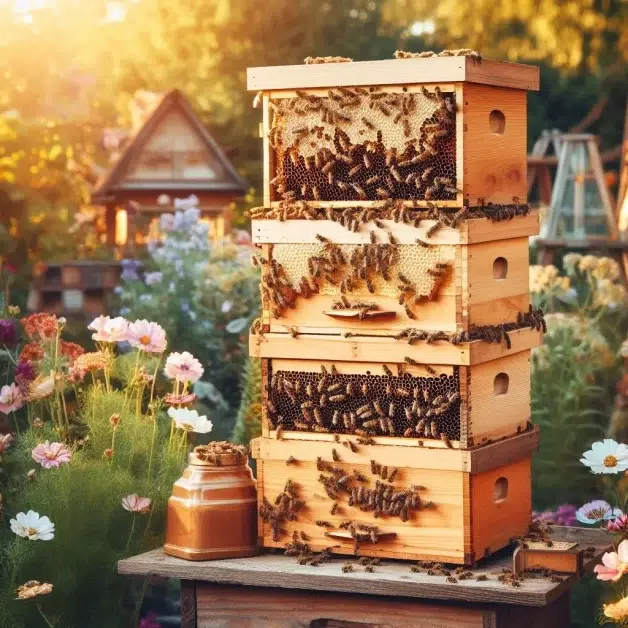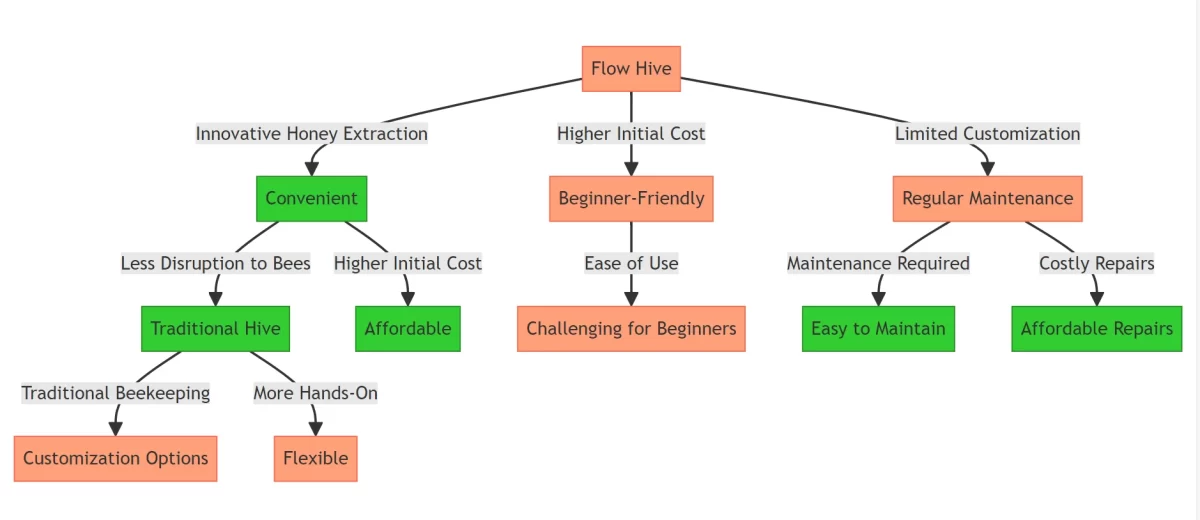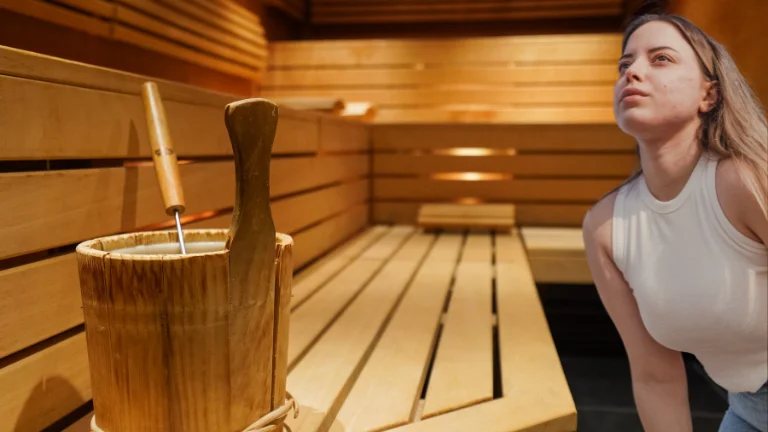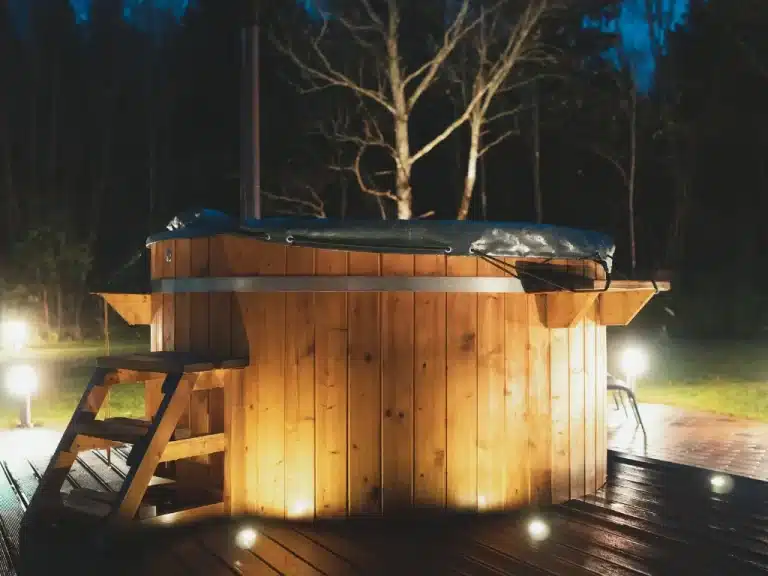5 Reasons Why You Should Choose a Flow Hive vs Traditional Hive
Discover the pros and cons of Flow Hive vs Traditional Hive in our comprehensive comparison. Make an informed choice for your beekeeping journey with our expert insights.
Beekeeping is a rewarding hobby that can provide delicious honey, pollination for your garden, and a deeper connection with nature. But if you are new to beekeeping, you might wonder which type of hive is best for you.
Many options are available, but two of the most popular are the Flow hive and the traditional Langstroth hive.
In this article, I will compare these two hives and give five reasons to choose a Flow hive over a traditional hive (Langstroth).
What is a Flow Hive?
A Flow hive is a modern hive that uses standard Langstroth frames. Beekeepers can harvest honey by inserting and turning a key that splits the honeycomb cells and releases honey through a tube. It is easier to manage than a Langstroth and requires no heavy lifting.

What is a Langstroth Hive?
A Langstroth hive is the most commonly used vertical beehive in the U.S. It is named after its American inventor, Reverend Lorenzo Langstroth, who patented it in 1852. It consists of oblong timber boxes stacked vertically, each containing removable frames with wax sheets.
The bottom box is usually the brood box, where the queen lays eggs, and the bees raise their young. The upper boxes are the honey supers, where the bees store excess honey.

5 Reasons to Choose a Flow Hive
Here are five reasons why you should choose a Flow hive over a traditional hive:
1. Easier Honey Harvesting
One of the main advantages of a Flow hive is that it allows you to harvest honey without opening the hive or concerning the bees. You simply insert and turn a key that splits the honeycomb cells and lets the honey flow through a tube into a jar or bucket.
This means you don’t need to use any special beekeeping equipment, such as a smoker, a bee suit, an extractor, or a strainer. You also don’t need to worry about damaging the comb or injuring the bees.
2. Less Mess and Waste
Another benefit of a Flow hive is that it reduces the mess and waste associated with traditional honey harvesting. When you use a Langstroth hive, remove the frames from the hive, cut off the wax cappings, spin the frames in an extractor, and strain the honey through a filter.
This process can be messy, time-consuming, and wasteful. You must also deal with sticky wax and propolis residue that can attract pests and diseases. You can avoid all these hassles with a Flow hive and enjoy pure, unprocessed honey straight from the hive.
3. More Control and Convenience
A Flow hive gives you more control and convenience over your honey production. Depending on your needs and preferences, you can decide when and how much honey to harvest. You can also monitor the progress of your bees and their honey storage through observation windows on the side and rear of the hive.
You can even harvest honey from individual frames or sections of frames, allowing you to enjoy different flavors and colors of honey from different flowers.
4. Better for the Bees
A Flow hive is not only good for you but also for your bees. Harvesting honey without opening the hive minimizes the stress and disruption for your bees. You also preserve their natural comb structure and avoid exposing them to potential contaminants or infections from outside sources.
Additionally, you can leave enough honey for your bees to survive the winter or periods of dearth, ensuring their health and well-being.
5. More Fun and Satisfaction
Finally, a Flow hive can make beekeeping more fun and satisfying. You can watch your bees at work through the observation windows, see how they build their comb, and fill it with honey. You can also share the experience of harvesting honey with your family and friends, who will be amazed by the fresh honey flowing out of your hive.
You can also taste different honey varieties from your backyard and appreciate nature’s diversity and richness. If you want to start beekeeping or upgrade your existing hive, I recommend you check out Flow Hive today.
[wps_youtube url=”https://youtu.be/zt-9tmsW4o8″ responsive=”yes” autoplay=”yes”]
Comparison Table: Flow Hive vs Traditional Hive:
[wps_table style=”default”]
| Feature | Flow Hive | Langstroth Hive |
|---|---|---|
| Honey Harvesting | Easy and convenient with a key; no need to open the hive. | Difficult and laborious, requiring smoker, bee suit, extractor, and manual extraction. |
| Mess and Waste | Minimal mess with no sticky residue or damage to comb. | Significant mess with sticky residue, potential damage to comb, attracting pests. |
| Control and Convenience | High control, decide when and how much to harvest, observation windows for monitoring. | Low control, follows a schedule, manual inspection required, harvesting from whole frames. |
| Bee Welfare | Good, minimizes stress, preserves natural comb structure, avoids exposure to contaminants. | Poor, causes stress, damages natural comb structure, exposes bees to potential infections. |
| Fun and Satisfaction | High satisfaction, observe bees through windows, share honey harvesting experience. | Low satisfaction, miss bee observations, deal with tedious traditional methods, less honey variety. |
[/wps_table]
I hope this table helps you understand the differences between a Flow hive vs traditional hive (Langstroth).
Golden Palace Auto Flow Beehive 7pcs Super Box Free Flow Frame (Outer Hive Frame Set)
Harvest fresh, unfiltered honey directly from your hive with the Golden Palace Auto Flow Beehive. This innovative hive features Flow frames, which allow you to extract honey without opening the hive, disturbing the bees, or using any special equipment. Simply turn the key and watch as pure, fresh honey flows into your jar.
Features:
- Outer wood box made by Fir Wood
- Flow frames made by food grade, BPA free, FDA certificated plastic
- Easy to use: harvest honey with the turn of a key
- No disturbance to the bees
- Safe for beekeepers
- Includes 7 Flow frames
- Instruction manual included
Additional Information:
- Dimensions: 20.07″D x 16.14″W x 27.16″H
- Weight: 25 pounds
- Color: Outer hive with 7pcs flows frame set
Benefits:
- Harvest fresh, unfiltered honey directly from your hive
- Easy to use: no special equipment required
- Safe for beekeepers and bees
- Produce a high yield of honey
- Enjoy the satisfaction of harvesting your own honey
Hot Tub Patio: A Surprising Connection
The correlation between beekeeping and hot tub patios may not seem apparent initially. Yet, the peaceful ambiance of a well-maintained patio garden often complements the serenity of beekeeping. Additionally, the heat emanating from a nearby hot tub during cooler seasons can aid beehives in maintaining optimal temperatures.
Problem-Solving Tips for Beekeepers
Beekeeping, while rewarding, presents its challenges. To aid beekeepers in navigating these hurdles, here are some problem-solving tips:
- Pest Management: Implement natural remedies or integrated pest management techniques to safeguard hives.
- Hive Maintenance: Inspect and maintain hives to ensure structural integrity and bee health.
- Environmental Awareness: Foster a bee-friendly environment by planting diverse flora and minimizing pesticide use.
Visit more about Hot tubs Patio, and for more information about Beekeeping.
Final Words: Which Hive Is Right for You?
In beekeeping, the choice between a Flow Hive vs Traditional Hive hinges on multiple factors. While statistics offer insights, the decision ultimately rests on personal preferences, goals, and the level of involvement desired. Both hive types have their merits and drawbacks, catering to different beekeepers’ needs.
In conclusion, whether you opt for a tradition steeped in history or innovation driving efficiency, consider what aligns with your ethos as a beekeeper. Embrace the hive that resonates with your passion for nurturing these invaluable pollinators.
Would you prioritize tradition or innovation in your beekeeping journey?












